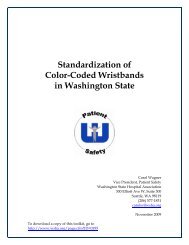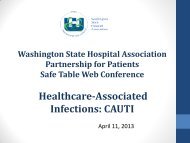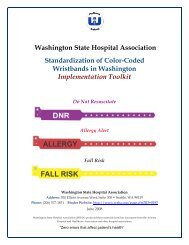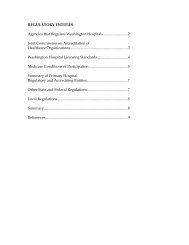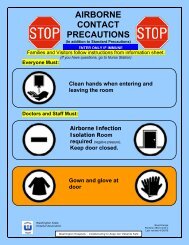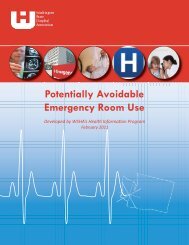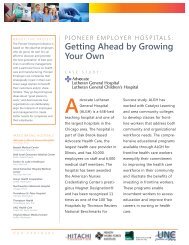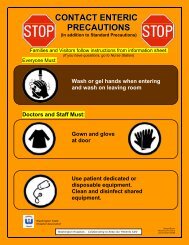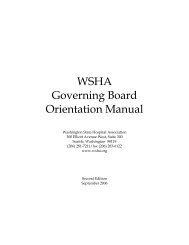Strategies to Prevent Central LineâAssociated Bloodstream ...
Strategies to Prevent Central LineâAssociated Bloodstream ...
Strategies to Prevent Central LineâAssociated Bloodstream ...
Create successful ePaper yourself
Turn your PDF publications into a flip-book with our unique Google optimized e-Paper software.
S22 infection control and hospital epidemiology oc<strong>to</strong>ber 2008, vol. 29, supplement 1supplement article: shea/idsa practice recommendation<strong>Strategies</strong> <strong>to</strong> <strong>Prevent</strong> <strong>Central</strong> Line–Associated <strong>Bloodstream</strong>Infections in Acute Care HospitalsJonas Marschall, MD; Leonard A. Mermel, DO, ScM; David Classen, MD, MS; Kathleen M. Arias, MS, CIC;Kelly Podgorny, RN, MS, CPHQ; Deverick J. Anderson, MD, MPH; Helen Burstin, MD; David P. Calfee, MD, MS;Susan E. Coffin, MD, MPH; Erik R. Dubberke, MD; Vic<strong>to</strong>ria Fraser, MD; Dale N. Gerding, MD;Frances A. Griffin, RRT, MPA; Peter Gross, MD; Keith S. Kaye, MD; Michael Klompas, MD; Evelyn Lo, MD;Lindsay Nicolle, MD; David A. Pegues, MD; Trish M. Perl, MD; Sanjay Saint, MD; Cassandra D. Salgado, MD, MS;Robert A. Weinstein, MD; Robert Wise, MD; Deborah S. Yokoe, MD, MPHpurposePreviously published guidelines are available that providecomprehensive recommendations for detecting and preventinghealthcare-associated infections. The intent of this documentis <strong>to</strong> highlight practical recommendations in a conciseformat designed <strong>to</strong> assist acute care hospitals in implementingand prioritizing their central line–associated bloodstream infection(CLABSI) prevention efforts. Refer <strong>to</strong> the Society forHealthcare Epidemiology of America/Infectious Diseases Societyof America “Compendium of <strong>Strategies</strong> <strong>to</strong> <strong>Prevent</strong>Healthcare-Associated Infections” Executive Summary andIntroduction and accompanying edi<strong>to</strong>rial for additionaldiscussion.section 1: rationale and statementsof concern1. Patients at risk for CLABSIs in acute care facilitiesa. Intensive care unit (ICU) population: The risk ofCLABSI in ICU patients is high. Reasons for this includethe frequent insertion of multiple catheters, the use of specifictypes of catheters that are almost exclusively insertedin ICU patients and associated with substantial risk (eg,arterial catheters), and the fact that catheters are frequentlyplaced in emergency circumstances, repeatedly accessedeach day, and often needed for extended periods. 1,2b. Non-ICU population: Although the primary focus ofattention over the past 2 decades has been the ICU setting,recent data suggest that the greatest numbers of patientswith central lines are in hospital units outside the ICU,where there is a substantial risk of CLABSI. 3-52. Outcomes associated with hospital-acquired CLABSIa. Increased length of hospital stay 6-10b. Increased cost; the non–inflation-adjusted attributablecost of CLABSIs has been found <strong>to</strong> vary from $3,700<strong>to</strong> $29,000 per episode 7,10,113. Independent risk fac<strong>to</strong>rs for CLABSI (in 2 or more publishedstudies) 12-14Note: femoral catheterization was found <strong>to</strong> be an independentrisk fac<strong>to</strong>r in 1 study. 15a. Fac<strong>to</strong>rs associated with increased riski. Prolonged hospitalization before catheterizationii. Prolonged duration of catheterizationiii. Heavy microbial colonization at the insertion siteiv. Heavy microbial colonization of the catheter hubv. Internal jugular catheterizationFrom the Washing<strong>to</strong>n University School of Medicine, St. Louis, Missouri (J.M., E.R.D., V.F.); the Warren Alpert Medical School of Brown University andRhode Island Hospital, Providence, Rhode Island (L.A.M.); the University of Utah, Salt Lake City (D.C.); the Association for Professionals in InfectionControl and Epidemiology (K.M.A.) and the National Quality Forum (H.B.), Washing<strong>to</strong>n, D.C.; the Joint Commission, Oakbrook Terrace (K.P., R.W.), theLoyola University Chicago Stritch School of Medicine (D.N.G.) and the Stroger (Cook County) Hospital and Rush University Medical Center (R.A.W.),Chicago, and the Hines Veterans Affairs Medical Center, Hines (D.N.G.), Illinois; the Duke University Medical Center, Durham, North Carolina (D.J.A.,K.S.K.); the Mount Sinai School of Medicine, New York, New York (D.P.C.); the Children’s Hospital of Philadelphia and University of Pennsylvania Schoolof Medicine, Philadelphia, Pennsylvania (S.E.C.); the Institute for Healthcare Improvement, Cambridge (F.A.G.), and Brigham and Women’s Hospital andHarvard Medical School, Bos<strong>to</strong>n (D.S.Y., M.K.), Massachusetts; the Hackensack University Medical Center, Hackensack (P.G.), and the University of Medicineand Dentistry–New Jersey Medical School, Newark (P.G.), New Jersey; the David Geffen School of Medicine at the University of California, Los Angeles(D.A.P.); the Johns Hopkins Medical Institutions and University, Baltimore, Maryland (T.M.P.); the Ann Arbor Veterans Affairs Medical Center and theUniversity of Michigan Medical School, Ann Arbor, Michigan (S.S.); the Medical University of South Carolina, Charles<strong>to</strong>n (C.D.S.); and the University ofMani<strong>to</strong>ba, Winnipeg, Canada (E.L., L.N.).Accepted June 9, 2008; electronically published September 16, 2008.Infect Control Hosp Epidemiol 2008; 29:S22–S30 2008 by The Society for Healthcare Epidemiology of America. All rights reserved. 0899-823X/2008/2910S1-0004$15.00. DOI: 10.1086/591059
strategies for prevention of clabsiS23vi. Neutropeniavii. Prematurity (ie, birth at an early gestational age)viii. Total parenteral nutritionix. Substandard care of the catheter (eg, excessive manipulationof the catheter or reduced nurse-<strong>to</strong>-patientratio)b. Fac<strong>to</strong>rs associated with reduced riski. Female sexsection 2: strategies <strong>to</strong> detectclabsi1. Surveillance pro<strong>to</strong>col and definitionsa. Use consistent surveillance methods and definitions<strong>to</strong> allow comparison with benchmark datab. Refer <strong>to</strong> the NHSN Manual: Patient Safety ComponentPro<strong>to</strong>col 16 for information on the appropriate surveillancemethodology, including information about blood specimencollection, and for surveillance definitions of CLABSI. Therelevant sections of the manual are “Identifying HealthcareassociatedInfections (HAI) in NHSN,” “Device-AssociatedModule: Methodology,” and “Device-Associated Module:<strong>Central</strong> Line-Associated <strong>Bloodstream</strong> Infection (CLABSI)Event.”section 3: strategies <strong>to</strong> preventclabsi1. Existing guidelines and recommendationsa. Several governmental, public health, and professionalorganizations have published evidence-based guidelinesand/or implementation aids regarding the prevention ofCLABSI, including the following:i. The Healthcare Infection Control Practices AdvisoryCommittee 17ii. The Institute for Healthcare Improvement 18 andiii. Making Health Care Safer, Agency for HealthcareResearch and Quality 19b. The recommendations in this document focus oncentral venous catheters (CVCs) unless noted otherwise.i. These recommendations are not stratified on thebasis of the type of catheter (eg, tunneled, implanted,cuffed, noncuffed catheter, or dialysis catheter).ii. These recommendations may not be applicable forprevention of bloodstream infections with other intravasculardevices.2. Infrastructure requirementsa. An adequately staffed infection prevention and controlprogram responsible for identifying patients withCLABSIb. Information technology <strong>to</strong> collect and calculate catheter-daysas a denomina<strong>to</strong>r for computing rates of CLABSIand patient-days <strong>to</strong> allow calculation of CVC utilization;catheter-days from information systems should be validatedagainst a manual method.c. Resources <strong>to</strong> provide appropriate education andtrainingd. Adequate labora<strong>to</strong>ry support for timely processing ofspecimens and reporting of results3. Practical implementationa. Educate physicians, nurses, and other healthcare personnelabout guidelines <strong>to</strong> prevent CLABSI (eg, with onlineand paper versions). These guidelines should be easilyaccessible.b. Develop and implement a catheter insertion checklist.Educate nurses, physicians, and other healthcare personnelinvolved in catheter insertion, regarding the use of thecatheter insertion checklist.c. Educate healthcare personnel about the insertion andmaintenance of catheters. 20 One method is <strong>to</strong> requirehealthcare personnel <strong>to</strong> complete an educational programincluding a posteducation test <strong>to</strong> ensure their knowledgeand competency before being allowed <strong>to</strong> insert CVCs.d. Establish catheter insertion kits/carts containing allnecessary items for insertion.section 4: recommendations forimplementing prevention andmoni<strong>to</strong>ring strategiesRecommendations for preventing and moni<strong>to</strong>ring CLABSIare summarized in the following section. They are designed<strong>to</strong> assist acute care hospitals in prioritizing and implementingtheir CLABSI prevention efforts. Criteria for grading thestrength of the recommendation and quality of evidence aredescribed in the Table.Note: Some of the following measures have been combinedin<strong>to</strong> a “prevention bundle” that focuses on catheter insertion(eg, measures B.2, B.3, B.5, B.6, and C.2). 22-24I. Basic practices for prevention and moni<strong>to</strong>ring ofCLABSI: recommended for all acute care hospitalsA. Before insertion1. Educate healthcare personnel involved in the insertion,care, and maintenance of CVCs about CLABSI prevention(A-II). 20,25-28a. Include the indications for catheter use, appropriateinsertion and maintenance, the risk of CLABSI, and generalinfection prevention strategies.b. Ensure that all healthcare personnel involved in catheterinsertion and maintenance complete an educationalprogram regarding basic practices <strong>to</strong> prevent CLABSI beforeperforming these duties.c. Periodically assess healthcare personnel knowledge ofand adherence <strong>to</strong> preventive measures.d. Ensure that any healthcare professional who insertsa CVC undergoes a credentialing process (as established
S24 infection control and hospital epidemiology oc<strong>to</strong>ber 2008, vol. 29, supplement 1table. Strength of Recommendation and Quality of EvidenceCategory/gradeStrength of recommendationABCQuality of evidenceIIIIIIDefinitionGood evidence <strong>to</strong> support a recommendation for useModerate evidence <strong>to</strong> support a recommendation for usePoor evidence <strong>to</strong> support a recommendationEvidence from x1 properly randomized, controlled trialEvidence from x1 well-designed clinical trial, withoutrandomization; from cohort or case-control analyticstudies (preferably from 11 center); from multipletime series; or from dramatic results of uncontrolledexperimentsEvidence from opinions of respected authorities, basedon clinical experience, descriptive studies, or reportsfrom expert committeesnote. Adapted from the Canadian Task Force on the Periodic Health Examination. 21by the individual healthcare institution) <strong>to</strong> ensure theircompetency before they independently insert a CVC.B. At insertion1. Use a catheter checklist <strong>to</strong> ensure adherence <strong>to</strong> infectionprevention practices at the time of CVC insertion (B-II). 23,29a. Use a checklist <strong>to</strong> ensure and document compliancewith aseptic technique.i. CVC insertion should be observed by a nurse, physician,or other healthcare personnel who has receivedappropriate education (see above), <strong>to</strong> ensure that aseptictechnique is maintained.b. These healthcare personnel should be empowered <strong>to</strong>s<strong>to</strong>p the procedure if breaches in aseptic technique areobserved.2. Perform hand hygiene before catheter insertion or manipulation(B-II). 30-33a. Use an alcohol-based waterless product or antisepticsoap and water.i. Use of gloves does not obviate hand hygiene.3. Avoid using the femoral vein for central venous accessin adult patients (A-I). 15,34,35a. Use of the femoral access site is associated with greaterrisk of infection and deep venous thrombosis in adults.i. Increased risk of infection with femoral cathetersmay be limited <strong>to</strong> overweight adult patients with a bodymass index higher than 28.4. 36ii. Femoral vein catheterization can be done withoutgeneral anesthesia in children and has not been associatedwith an increased risk of infection in children. 37b. Several nonrandomized studies show that the subclavianvein site is associated with a lower risk of CLABSIthan is the internal jugular vein, but the risks and benefitsin light of potential infectious and noninfectious complicationsmust be considered on an individual basis whendetermining which insertion site <strong>to</strong> use.c. The use of peripherally inserted CVCs is not an evidence-basedstrategy <strong>to</strong> reduce the risk of CLABSI.i. The risk of infection with peripherally insertedCVCs in ICU patients approaches that with CVCs placedin the subclavian or internal jugular veins. 384. Use an all-inclusive catheter cart or kit (B-II). 23a. A catheter cart or kit that contains all necessary componentsfor aseptic catheter insertion is <strong>to</strong> be available andeasily accessible in all units where CVCs are inserted.5. Use maximal sterile barrier precautions during CVCinsertion (A-I). 39-42a. Use maximal sterile barrier precautions.i. A mask, cap, sterile gown, and sterile gloves are <strong>to</strong>be worn by all healthcare personnel involved in the catheterinsertion procedure.ii. The patient is <strong>to</strong> be covered with a large steriledrape during catheter insertion.b. These measures must also be followed when exchanginga catheter over a guidewire.6. Use a chlorhexidine-based antiseptic for skin preparationin patients older than 2 months of age (A-I). 43-46a. Before catheter insertion, apply an alcoholic chlorhexidinesolution containing a concentration of chlorhexidinegluconate greater than 0.5% <strong>to</strong> the insertion site.i. The antiseptic solution must be allowed <strong>to</strong> dry beforemaking the skin puncture.ii. Chlorhexidine products are not approved by theUS Food and Drug Administration for children younger
strategies for prevention of clabsiS25than 2 months of age; povidone-iodine can be used forchildren in this age group.C. After insertion1. Disinfect catheter hubs, needleless connec<strong>to</strong>rs, and injectionports before accessing the catheter (B-II). 47-49a. Before accessing catheter hubs or injection ports,clean them with an alcoholic chlorhexidine preparation or70% alcohol <strong>to</strong> reduce contamination.2. Remove nonessential catheters (A-II). 50,51a. Assess the need for continued intravascular access ona daily basis during multidisciplinary rounds. Removecatheters not required for patient care.3. For nontunneled CVCs in adults and adolescents,change transparent dressings and perform site care with achlorhexidine-based antiseptic every 5-7 days or more frequentlyif the dressing is soiled, loose, or damp; change gauzedressings every 2 days or more frequently if the dressing issoiled, loose, or damp (A-I). 52,534. Replace administration sets not used for blood, bloodproducts, or lipids at intervals not longer than 96 hours (A-II). 545. Perform surveillance for CLABSI (B-II). 55a. Measure unit-specific incidence of CLABSI (CLABSIsper 1,000 catheter-days) and report the data on a regularbasis <strong>to</strong> the units, physician and nursing leadership, andhospital administra<strong>to</strong>rs overseeing the units.b. Compare CLABSI incidence with his<strong>to</strong>rical data forindividual units and with national rates (ie, data from theNational Healthcare Safety Network 56 ).c. CLABSI has been documented in large numbers ofnon-ICU patients with CVCs. Surveillance for CLABSI inthese settings requires additional resources. 4,5,576. Use antimicrobial ointments for hemodialysis catheterinsertion sites (A-I). 58-62a. Povidone-iodine or polysporin ointment should beapplied <strong>to</strong> hemodialysis catheter insertion sites in patientswith a his<strong>to</strong>ry of recurrent Staphylococcus aureus CLABSI.b. Mupirocin ointment should not be applied <strong>to</strong> thecatheter insertion site due <strong>to</strong> the risks of mupirocin resistanceand damage <strong>to</strong> polyurethane catheters.D. Accountability1. The hospital’s chief executive officer and senior managementare responsible for ensuring that the healthcare systemsupports an infection prevention and control programthat effectively prevents the occurrence of CLABSI.2. Senior management is accountable for ensuring that anadequate number of trained personnel are assigned <strong>to</strong> theinfection prevention and control program.3. Senior management is accountable for ensuring thathealthcare personnel, including licensed and nonlicensed personnel,are competent <strong>to</strong> perform their job responsibilities.4. Direct healthcare providers (such as physicians, nurses,aides, and therapists) and ancillary personnel (such as housekeepingand equipment-processing personnel) are responsiblefor ensuring that appropriate infection prevention and controlpractices are used at all times (including hand hygiene,standard and isolation precautions, cleaning and disinfectionof equipment and the environment, aseptic technique wheninserting and caring for CVCs, maximal barrier precautions,appropriate site selection, and daily assessment of the needfor a CVC).5. Hospital and unit leaders are responsible for holdingpersonnel accountable for their actions.6. The person who manages the infection prevention andcontrol program is responsible for ensuring that an activeprogram <strong>to</strong> identify CLABSIs is implemented, that data onCLABSIs are analyzed and regularly provided <strong>to</strong> those whocan use the information <strong>to</strong> improve the quality of care (eg,unit staff, clinicians, and hospital administra<strong>to</strong>rs), and thatevidence-based practices are incorporated in<strong>to</strong> the program.7. Individuals responsible for healthcare personnel and patienteducation are accountable for ensuring that appropriatetraining and educational programs <strong>to</strong> prevent CLABSIs aredeveloped and provided <strong>to</strong> personnel, patients, and families.8. Personnel from the infection prevention and controlprogram, labora<strong>to</strong>ry, and information technology departmentsare responsible for ensuring that systems are in place<strong>to</strong> support the surveillance program.II. Special approaches for the prevention of CLABSIPerform a CLABSI risk assessment. These special approachesare recommended for use in locations and/or populationswithin the hospital that have unacceptably high CLABSI ratesdespite implementation of the basic CLABSI prevention strategieslisted above.1. Bathe ICU patients older than 2 months of age with achlorhexidine preparation on a daily basis (B-II). 63a. Chlorhexidine products are not approved by the USFood and Drug Administration for children younger than2 months of age but are used at some institutions forcleaning CVC insertion sites or as a sponge dressing forchildren in this age group.
S26 infection control and hospital epidemiology oc<strong>to</strong>ber 2008, vol. 29, supplement 1b. A povidone-iodine preparation should be used <strong>to</strong>clean CVC insertion sites for children younger than 2months of age, especially low-birth-weight neonates.2. Use antiseptic- or antimicrobial-impregnated CVCs foradult patients (A-I). 64-70a. The risk of CLABSI is reduced with some currentlymarketed catheters impregnated with antiseptics (eg, chlorhexidine-silversulfadiazine) or antimicrobials (eg, minocycline-rifampin).Consider the use of such catheters inthe following circumstances:i. Hospital units or patient populations have aCLABSI rate higher than the institutional goal, despitecompliance with basic CLABSI prevention practices.ii. Patients have limited venous access and a his<strong>to</strong>ryof recurrent CLABSI.iii. Patients are at heightened risk for severe sequelaefrom a CLABSI (eg, patients with recently implantedintravascular devices, such as a prosthetic heart valve oraortic graft).b. These catheters are not approved by the US Food andDrug Administration for use in children.i. Preliminary data suggest that antimicrobial-impregnatedcatheters appear <strong>to</strong> be safe and may holdpromise for pediatric ICU patients. 71,723. Use chlorhexidine-containing sponge dressings forCVCs in patients older than 2 months of age (B-I). 73-75a. Consider the addition of such a dressing in the followingcircumstances:i. Hospital units or patient populations have aCLABSI rate higher than the institutional goal, despitecompliance with an evidence-based prevention bundle.ii. Patients have limited venous access and a his<strong>to</strong>ryof recurrent CLABSI.iii. Patients are at heightened risk for severe sequelaefrom a CLABSI (eg, patients with recently implantedintravascular devices, such as a prosthetic heart valve oraortic graft).b. Do not use chlorhexidine-containing sponge dressingsfor low-birth-weight neonates.4. Use antimicrobial locks for CVCs (A-I). 76-80a. Antibiotic locks are created by filling the lumen ofthe catheter with a supraphysiologic concentration of anantimicrobial solution and leaving the solution in placeuntil the catheter hub is reaccessed. Such an approach canreduce the risk of CLABSI. Because of concerns regardingthe potential for the emergence of resistance in exposedorganisms and the potential for systemic <strong>to</strong>xicity from leakageof the lock solution in<strong>to</strong> the bloodstream, use antimicrobiallocks as a preventative strategy only for the following:i. Prophylaxis for patients with limited venous accessand a his<strong>to</strong>ry of recurrent CLABSI.ii. Patients who are at heightened risk for severe sequelaefrom a CLABSI (eg, patients with recently implantedintravascular devices such as a prosthetic heartvalve or aortic graft).III. Approaches that should not be considered a routinepart of CLABSI prevention1. Do not use antimicrobial prophylaxis for short-term ortunneled catheter insertion or while catheters are in situ (A-I). 81-84 a. Systemic antimicrobial prophylaxis is not recommended.2. Do not routinely replace CVCs or arterial catheters (A-I). 85-87 a. Routine catheter replacement is not recommended.3. Do not routinely use positive-pressure needleless connec<strong>to</strong>rswith mechanical valves before a thorough assessmen<strong>to</strong>f risks, benefits, and education regarding proper use (B-II). 88-91a. Routine use of the currently marketed devices thatare associated with an increased risk of CLABSI is notrecommended.IV. Unresolved issues1. Nurse-<strong>to</strong>-patient ratio and use of float nurses inICUs 92-94a. Observational studies suggest that there should be anurse-<strong>to</strong>-patient ratio of at least 2 : 1 in ICUs where nursesare managing patients with CVCs and that the number offloat nurses working in the ICU environment should beminimized. Formal recommendations await the results ofinterventional trials.2. Intravenous therapy teams for reducing CLABSI rates 95a. Studies have shown that an intravenous therapy teamresponsible for insertion and maintenance of peripheralintravenous catheters reduces the risk of bloodstream infections.96 However, few studies have been performed regardingthe impact of intravenous therapy teams onCLABSI rates.3. Surveillance of other types of catheters (eg, peripheralarterial catheters) 1,2a. Peripheral arterial catheters have not been includedin most surveillance systems, although they are associatedwith a risk of bloodstream infection. Future surveillancesystems may need <strong>to</strong> include bloodstream infections associatedwith these types of catheters.
strategies for prevention of clabsiS274. Estimating catheter-days for determining incidencedensity of CLABSIa. Surveillance can be facilitated in settings with a limitedworkforce by estimating the number of catheterdays.97,98section 5: performance measuresI. Internal reportingThese performance measures are intended <strong>to</strong> support internalhospital quality improvement efforts and do not necessarilyaddress external reporting needs.The process and outcome measures suggested here are derivedfrom published guidelines, other relevant literature, andthe opinion of the authors. Report process and outcome measures<strong>to</strong> senior hospital leadership, nursing leadership, andclinicians who care for patients at risk for CLABSI.A. Process measures (in rank order from highest <strong>to</strong> lowestpriority)1. Compliance with CVC insertion guidelines as documentedon an insertion checklista. Assess compliance with the checklist in all hospitalsettings where CVCs are inserted (eg, ICUs, emergencydepartment, operating room, radiology, and general wards)and assign healthcare personnel familiar with catheter care<strong>to</strong> this task.i. For an example of a central catheter checklist, seethe Institute for Healthcare Improvement Web site. 99b. Measure the percentage of CVC insertion proceduresin which compliance with appropriate hand hygiene, useof maximal sterile barrier precautions, and use of chlorhexidine-basedcutaneous antisepsis of the insertion site isdocumented.i. Numera<strong>to</strong>r: number of CVC insertions that havedocumented the use of all 3 interventions (hand hygiene,maximal barrier precautions, and chlorhexidine-basedcutaneous antiseptic use) performed at the time of CVCinsertion.ii. Denomina<strong>to</strong>r: number of all CVC insertions.iii. Multiply by 100 so that the measure is expressedas a percentage.2. Compliance with documentation of daily assessment regardingthe need for continuing CVC accessa. Measure the percentage of patients with a CVC forwhom there is documentation of daily assessment.i. Numera<strong>to</strong>r: number of patients with a CVC forwhom there is documentation of daily assessment.ii. Denomina<strong>to</strong>r: number of patients with a CVC.iii. Multiply by 100 so that the measure is expressedas a percentage.3. Compliance with cleaning of catheter hubs and injectionports before they are accesseda. Assess compliance through observations of practice.i. Numera<strong>to</strong>r: number of times that a catheter hubor port is observed <strong>to</strong> be cleaned before being accessed.ii. Denomina<strong>to</strong>r: number of times a catheter hub orport is observed <strong>to</strong> be accessed.iii. Multiply by 100 so that the measure is expressedas a percentage.4. Compliance with avoiding the femoral vein site for CVCinsertion in adult patientsa. Perform point prevalence surveys or use informationcollected as part of the central line insertion checklist <strong>to</strong>determine the percentage of patients whose CVCs are inthe femoral vein versus the subclavian or internal jugularveins.b. Calculate the percentage of patients with a femoralvein catheter.i. Numera<strong>to</strong>r: number of patients with a CVC in thefemoral vein.ii. Denomina<strong>to</strong>r: <strong>to</strong>tal number of patients with a CVCin unit population being assessed.iii. Multiply by 100 so that the measure is expressedas a percentage.B. Outcome measures1. CLABSI ratea. Use National Healthcare Safety Network definitions.i. Numera<strong>to</strong>r: number of CLABSIs in each unit assessed(using National Healthcare Safety Networkdefinitions).ii. Denomina<strong>to</strong>r: <strong>to</strong>tal number of catheter-days ineach unit assessed (using National Healthcare SafetyNetwork definitions).iii. Multiply by 1,000 so that the measure is expressedas number of CLABSIs per 1,000 catheter-days.iv. Risk adjustment: stratify CLABSI rates by type ofpatient-care unit. 100-102(a) Report comparisons based on his<strong>to</strong>rical dataand National Healthcare Safety Network data, ifavailable. 56II. External reportingThere are many challenges in providing useful information<strong>to</strong> consumers and other stakeholders while preventing unintendedadverse consequences of public reporting of healthcare-associatedinfections. 103 Recommendations for public reportingof healthcare-associated infections have beenprovided by the Healthcare Infection Control Practices AdvisoryCommittee, 104 the Healthcare-Associated InfectionWorking Group of the Joint Public Policy Committee, 105 andthe National Quality Forum. 106
S28 infection control and hospital epidemiology oc<strong>to</strong>ber 2008, vol. 29, supplement 1A. State and federal requirements1. Hospitals in states that have manda<strong>to</strong>ry reporting requirementsfor CLABSI must collect and report the data requiredby the state.2. For information on state and federal requirements, contactyour state or local health department.B. External quality initiatives1. Hospitals that participate in external quality initiativesor state programs must collect and report the data requiredby the initiative or the program.acknowledgmentsFor Potential Conflicts of Interest statements and information on financialsupport, please see the Acknowledgments in the Executive Summary, on pageS20 of this supplement.Address reprint requests <strong>to</strong> the Reprints Coordina<strong>to</strong>r, University of ChicagoPress, 1427 E. 60th St., Chicago, IL 60637 (reprints@press.uchicago.edu)or contact the journal office (iche@press.uchicago.edu).references1. Maki DG, Kluger DM, Crnich CJ. The risk of bloodstream infectionin adults with different intravascular devices: a systematic review of 200published prospective studies. Mayo Clin Proc 2006; 81:1159-1171.2. Esteve F, Pujol M, Limon E, et al. <strong>Bloodstream</strong> infection related <strong>to</strong>catheter connections: a prospective trial of two connection systems. JHosp Infect 2007; 67:30-34.3. Climo M, Diekema D, Warren DK, et al. Prevalence of the use of centralvenous access devices within and outside of the intensive care unit:results of a survey among hospitals in the prevention epicenter programof the Centers for Disease Control and <strong>Prevent</strong>ion. Infect Control HospEpidemiol 2003; 24:942-945.4. Vonberg RP, Behnke M, Geffers C, et al. Device-associated infectionrates for non–intensive care unit patients. Infect Control Hosp Epidemiol2006; 27:357-361.5. Marschall J, Leone C, Jones M, Nihill D, Fraser VJ, Warren DK. Catheter-associatedbloodstream infections in general medical patients outsidethe intensive care unit: a surveillance study. Infect Control HospEpidemiol 2007; 28:905-909.6. Pittet D, Tarara D, Wenzel RP. Nosocomial bloodstream infection incritically ill patients: excess length of stay, extra costs, and attributablemortality. JAMA 1994; 271:1598-1601.7. DiGiovine B, Chenoweth C, Watts C, Higgins M. The attributable mortalityand costs of primary nosocomial bloodstream infections in theintensive care unit. Am J Respir Crit Care Med 1999; 160:976-981.8. Renaud B, Brun-Buisson C, ICU-Bacteremia Study Group. Outcomesof primary and catheter-related bacteremia: a cohort and case-controlstudy in critically ill patients. Am J Respir Crit Care Med 2001; 163:1584-1590.9. Dimick JB, Pelz RK, Consunji R, Swoboda SM, Hendrix CW, LipsettPA. Increased resource use associated with catheter-related bloodstreaminfection in the surgical intensive care unit. Arch Surg 2001; 136:229-234.10. Warren DK, Quadir WW, Hollenbeak CS, et al. Attributable cost ofcatheter-associated bloodstream infection among intensive care patientsin a nonteaching hospital. Crit Care Med 2006; 34:2084-2089.11. Mermel LA. <strong>Prevent</strong>ion of intravascular catheter-related infections(published correction appears in Ann Intern Med 2000; 133:5). AnnIntern Med 2000; 132:391-402.12. Mermel LA. Infections caused by intravascular devices. In: Pffeifer JA,ed. APIC Text of Infection Control and Epidemiology. 2nd ed. St. Louis:Mosby; 2000:30-38.13. Almuneef MA, Memish ZA, Balkhy HH, Hijazi O, Cunningham G,Francis C. Rate, risk fac<strong>to</strong>rs and outcomes of catheter-related bloodstreaminfection in a paediatric intensive care unit in Saudi Arabia. JHosp Infect 2006; 62:207-213.14. Alonso-Echanove J, Edwards JR, Richards MJ, et al. Effect of nursestaffing and antimicrobial-impregnated central venous catheters on therisk for bloodstream infections in intensive care units. Infect ControlHosp Epidemiol 2003; 24:916-925.15. Lorente L, Henry C, Martin MM, Jimenez A, Mora ML. <strong>Central</strong> venouscatheter-related infection in a prospective and observational study of2,595 catheters. Crit Care 2005; 9:R631-R635.16. National Healthcare Safety Network, Centers for Disease Controland <strong>Prevent</strong>ion. The National Healthcare Safety Network (NHSN)manual: patient safety component pro<strong>to</strong>col. January 2008. Availableat: http://www.cdc.gov/ncidod/dhqp/pdf/nhsn/NHSN_Manual_PatientSafetyPro<strong>to</strong>col_CURRENT.pdf. Accessed July 30, 2008.17. O’Grady NP, Alexander M, Dellinger EP, et al. Guidelines for the preventionof intravascular catheter-related infections. MMWR RecommRep 2002; 51(RR-10):1-29.18. Institute for Healthcare Improvement. Available at: http://www.ihi.org/ihi. Accessed July 15, 2008.19. Saint S. <strong>Prevent</strong>ion of intravascular catheter-associated infections. In:Making Health Care Safer: A Critical Analysis of Patient Safety Practices.Evidence report/technology assessment, no. 43. AHRQ publication no.01-E058. Rockville, MD: Agency for Healthcare Research and Quality;2001:163-183. Available at: http://www.ahrq.gov/clinic/ptsafety/. AccessedJuly 16, 2008.20. Sherertz RJ, Ely EW, Westbrook DM, et al. Education of physicians-intrainingcan decrease the risk for vascular catheter infection. Ann InternMed 2000; 132:641-648.21. Canadian Task Force on the Periodic Health Examination. The periodichealth examination. Can Med Assoc J 1979; 121:1193-1254.22. Pronovost P, Needham D, Berenholtz S, et al. An intervention <strong>to</strong> decreasecatheter-related bloodstream infections in the ICU. N Engl J Med2006; 355:2725-2732.23. Berenholtz SM, Pronovost PJ, Lipsett PA, et al. Eliminating catheterrelatedbloodstream infections in the intensive care unit. Crit Care Med2004; 32:2014-2020.24. Mu<strong>to</strong> C, Herbert C, Harrison E, et al. Reduction in central line-associatedbloodstream infections among patients in intensive care units—Pennsylvania, April 2001–March 2005. MMWR Morb Mortal Wkly Rep2005; 54:1013-1016.25. Eggimann P, Harbarth S, Constantin MN, Touveneau S, Chevrolet JC,Pittet D. Impact of a prevention strategy targeted at vascular-access careon incidence of infections acquired in intensive care. Lancet 2000; 355:1864-1868.26. Coopersmith CM, Rebmann TL, Zack JE, et al. Effect of an educationprogram on decreasing catheter-related bloodstream infections in thesurgical intensive care unit. Crit Care Med 2002; 30:59-64.27. Warren DK, Zack JE, Cox MJ, Cohen MM, Fraser VJ. An educationalintervention <strong>to</strong> prevent catheter-associated bloodstream infections in anonteaching, community medical center. Crit Care Med 2003; 31:1959-1963.28. Warren DK, Zack JE, Mayfield JL, et al. The effect of an educationprogram on the incidence of central venous catheter-associated bloodstreaminfection in a medical ICU. Chest 2004; 126:1612-1618.29. Tsuchida T, Makimo<strong>to</strong> K, Toki M, Sakai K, Onaka E, Otani Y. Theeffectiveness of a nurse-initiated intervention <strong>to</strong> reduce catheter-associatedbloodstream infections in an urban acute hospital: an interventionstudy with before and after comparison. Int J Nurs Stud 2007; 44:1324-1333.30. Occupational Health & Safety Administration, US Department of Labor.Available at: http://www.osha.gov/. Accessed July 15, 2008.
strategies for prevention of clabsiS2931. Yilmaz G, Koksal I, Aydin K, Caylan R, Sucu N, Aksoy F. Risk fac<strong>to</strong>rsof catheter-related bloodstream infections in parenteral nutrition catheterization.JPEN J Parenter Enteral Nutr 2007; 31:284-287.32. Boyce JM, Pittet D. Guideline for hand hygiene in health-care settings:recommendations of the Healthcare Infection Control Practices AdvisoryCommittee and the HICPAC/SHEA/APIC/IDSA Hand HygieneTask Force. Society for Healthcare Epidemiology of America/Associationfor Professionals in Infection Control/Infectious Diseases Society ofAmerica. MMWR Recomm Rep 2002; 51(RR-16):1-45.33. Rosenthal VD, Guzman S, Safdar N. Reduction in nosocomial infectionwith improved hand hygiene in intensive care units of a tertiary carehospital in Argentina. Am J Infect Control 2005; 33:392-397.34. Goetz AM, Wagener MM, Miller JM, Muder RR. Risk of infection due<strong>to</strong> central venous catheters: effect of site of placement and catheter type.Infect Control Hosp Epidemiol 1998; 19:842-845.35. Merrer J, De Jonghe B, Golliot F, et al. Complications of femoral andsubclavian venous catheterization in critically ill patients: a randomizedcontrolled trial. JAMA 2001; 286:700-707.36. Parienti JJ, Thirion M, Mégarbane B, et al. Femoral versus jugularcentral catheterization in patients requiring renal replacement therapy:a randomized controlled study. JAMA 2008; 299:2413-2422.37. De Jonge RCJ, Polderman KH, Gemke RJBJ. <strong>Central</strong> venous catheteruse in the pediatric patient: mechanical and infectious complications.Pediatr Crit Care Med 2005; 6:329-339.38. Safdar N, Maki DG. Risk of catheter-related bloodstream infection withperipherally inserted central venous catheters used in hospitalized patients.Chest 2005; 128:489-495.39. Mermel LA, McCormick RD, Springman SR, Maki DG. The pathogenesisand epidemiology of catheter-related infection with pulmonaryartery Swan-Ganz catheters: a prospective study utilizing molecularsubtyping. Am J Med 1991; 91:197S-205S.40. Raad II, Hohn DC, Gilbreath BJ, et al. <strong>Prevent</strong>ion of central venouscatheter-related infections by using maximal sterile barrier precautionsduring insertion. Infect Control Hosp Epidemiol 1994; 15:231-238.41. Hu KK, Lipsky BA, Veenstra DL, Saint S. Using maximal sterile barriers<strong>to</strong> prevent central venous catheter-related infection: a systematic evidence-basedreview. Am J Infect Control 2004; 32:142-146.42. Young EM, Commiskey ML, Wilson SJ. Translating evidence in<strong>to</strong> practice<strong>to</strong> prevent central venous catheter-associated bloodstream infections:a systems-based intervention. Am J Infect Control 2006; 34:503-506.43. Maki DG, Ringer M, Alvarado CJ. Prospective randomised trial of povidone-iodine,alcohol, and chlorhexidine for prevention of infectionassociated with central venous and arterial catheters. Lancet 1991; 338:339-343.44. Garland JS, Buck RK, Maloney P, et al. Comparison of 10% povidoneiodineand 0.5% chlorhexidine gluconate for the prevention of peripheralintravenous catheter colonization in neonates: a prospectivetrial. Pediatr Infect Dis J 1995; 14:510-516.45. Humar A, Ostromecki A, Direnfeld J, et al. Prospective randomizedtrial of 10% povidone-iodine versus 0.5% tincture of chlorhexidine ascutaneous antisepsis for prevention of central venous catheter infection.Clin Infect Dis 2000; 31:1001-1007.46. Chaiyakunapruk N, Veenstra DL, Lipsky BA, Saint S. Chlorhexidinecompared with povidone-iodine solution for vascular catheter-site care:a meta-analysis. Ann Intern Med 2002; 136:792-801.47. Salzman MB, Isenberg HD, Rubin LG. Use of disinfectants <strong>to</strong> reducemicrobial contamination of hubs of vascular catheters. J Clin Microbiol1993; 31:475-479.48. Luebke MA, Arduino MJ, Duda DL, et al. Comparison of the microbialbarrier properties of a needleless and a conventional needle-based intravenousaccess system. Am J Infect Control 1998; 26:437-441.49. Casey AL, Worthing<strong>to</strong>n T, Lambert PA, Quinn D, Faroqui, Elliott TS.A randomized, prospective clinical trial <strong>to</strong> assess the potential infectionrisk associated with the PosiFlow needleless connec<strong>to</strong>r. J Hosp Infect2003; 54:288-293.50. Lederle FA, Parenti CM, Berskow LC, Ellingson KJ. The idle intravenouscatheter. Ann Intern Med 1992; 116:737-738.51. Parenti CM, Lederle FA, Impola CL, Peterson LR. Reduction of unnecessaryintravenous catheter use: internal medicine house staff participatein a successful quality improvement project. Arch Intern Med1994; 154:1829-1832.52. Maki DG, S<strong>to</strong>lz SS, Wheeler S, Mermel LA. A prospective, randomizedtrial of gauze and two polyurethane dressings for site care of pulmonaryartery catheters: implications for catheter management. Crit Care Med1994; 22:1729-1737.53. Rasero L, Degl’Innocenti M, Mocali M, et al. Comparison of two differenttime interval pro<strong>to</strong>cols for central venous catheter dressing inbone marrow transplant patients: results of a randomized, multicenterstudy. Haema<strong>to</strong>logica 2000; 85:275-279.54. Gillies D, O’Riordan L, Wallen M, Morrison A, Rankin K, Nagy S.Optimal timing for intravenous administration set replacement. CochraneDatabase Syst Rev 2005; (4):1-42.55. Gastmeier P, Geffers C, Brandt C, et al. Effectiveness of a nationwidenosocomial infection surveillance system for reducing nosocomial infections.J Hosp Infect 2006; 64:16-22.56. National Healthcare Safety Network (NHSN), Department of Healthand Human Services, Centers for Disease Control and <strong>Prevent</strong>ion. Availableat: http://www.cdc.gov/ncidod/dhqp/nhsn.html. Accessed July 15,2008.57. Edwards JR, Peterson KD, Andrus ML, et al. National Healthcare SafetyNetwork (NHSN) report, data summary for 2006, issued June 2007.Am J Infect Control 2007; 35:290-301.58. Levin A, Mason AJ, Jindal KK, Fong IW, Goldstein MB. <strong>Prevent</strong>ion ofhemodialysis subclavian vein catheter infections by <strong>to</strong>pical povidoneiodine.Kidney Int 1991; 40:934-938.59. Zakrzewska-Bode A, Muytjens HL, Liem KD, Hoogkamp-Korstanje JA.Mupirocin resistance in coagulase-negative staphylococci, after <strong>to</strong>picalprophylaxis for the reduction of colonization of central venous catheters.J Hosp Infect 1995; 31:189-193.60. Riu S, Ruiz CG, Martinez-Vea A, Peralta C, Oliver JA. Spontaneousrupture of polyurethane peri<strong>to</strong>neal catheter: a possible deleterious effec<strong>to</strong>f mupirocin ointment. Nephrol Dial Transplant 1998; 13:1870-1871.61. Lok CE, Stanley KE, Hux JE, Richardson R, Tobe SW, Conly J. Hemodialysisinfection prevention with polysporin ointment. J Am SocNephrol 2003; 14:169-179.62. Fong IW. <strong>Prevent</strong>ion of haemodialysis and peri<strong>to</strong>neal dialysis catheterrelated infection by <strong>to</strong>pical povidone-iodine. Postgrad Med J 1993;69(Suppl 3):S15-S17.63. Bleasdale SC, Trick WE, Gonzales IM, Lyles RD, Hayden MK, WeinsteinRA. Effectiveness of chlorhexidine bathing <strong>to</strong> reduce catheter-associatedbloodstream infections in medical intensive care unit patients. ArchIntern Med 2007; 167:2073-2079.64. Maki DG, S<strong>to</strong>lz SM, Wheeler S, Mermel LA. <strong>Prevent</strong>ion of centralvenous catheter-related bloodstream infection by use of an antisepticimpregnatedcatheter: a randomized, controlled trial. Ann Intern Med1997; 127:257-266.65. Raad I, Darouiche R, Dupuis J. <strong>Central</strong> venous catheters coated withminocycline and rifampin for the prevention of catheter-related colonizationand bloodstream infections: a randomized, double-blind trial.The Texas Medical Center Catheter Study Group. Ann Intern Med 1997;127:267-274.66. Veenstra DL, Saint S, Saha S, Lumley T, Sullivan SD. Efficacy of antiseptic-impregnatedcentral venous catheters in preventing catheter-relatedbloodstream infections: a meta-analysis. JAMA 1999; 281:261-267.67. Darouiche RO, Raad II, Heard SO, et al. A comparison of two antimicrobial-impregnatedcentral venous catheters: Catheter Study Group.NEnglJMed1999; 340:1-8.68. Hanna HA, Raad II, Hackett B, et al., M.D. Anderson Catheter StudyGroup. Antibiotic-impregnated catheters associated with significant decreasein nosocomial and multidrug-resistant bacteremias in criticallyill patients. Chest 2003; 124:1030-1038.69. Hanna H, Benjamin R, Chatzinikolaou I, et al. Long-term silicone centralvenous catheters impregnated with minocycline and rifampin decreaserates of catheter-related bloodstream infection in cancer patients:a prospective randomized clinical trial. J Clin Oncol 2004; 22:3163-3171.
S30 infection control and hospital epidemiology oc<strong>to</strong>ber 2008, vol. 29, supplement 170. Rupp ME, Lisco SJ, Lipsett PA, et al. Effect of a second-generationvenous catheter impregnated with chlorhexidine and silver sulfadiazineon central catheter-related infections: a randomized, controlled trial.Ann Intern Med 2005; 143:570-580.71. Chelliah A, Heydon KH, Zaoutis TE, et al. Observational trial of antibiotic-coatedcentral venous catheters in critically ill pediatric patients.Pediatr Infect Dis J 2007; 26:816-820.72. Bhutta A, Gilliam C, Honeycutt M, et al. Reduction of bloodstreaminfections associated with catheters in paediatric intensive care unit:stepwise approach. BMJ 2007; 334:362-365.73. Garland JS, Alex CP, Mueller CD, et al. A randomized trial comparingpovidone-iodine <strong>to</strong> a chlorhexidine gluconate-impregnated dressing forprevention of central venous catheter infections in neonates. Pediatrics2001; 107:1431-1436.74. Levy I, Katz J, Solter E, et al. Chlorhexidine-impregnated dressing forprevention of colonization of central venous catheters in infants andchildren: a randomized controlled study. Pediatr Infect Dis J 2005; 24:676-679.75. Ho KM, Lit<strong>to</strong>n E. Use of chlorhexidine-impregnated dressing <strong>to</strong> preventvascular and epidural catheter colonization and infection: a meta-analysis.J Antimicrob Chemother 2006; 58:281-287.76. Carratala J, Niubo J, Fernandez-Sevilla A, et al. Randomized, doubleblindtrial of an antibiotic-lock technique for prevention of gram-positivecentral venous catheter-related infection in neutropenic patientswith cancer. Antimicrob Agents Chemother 1999; 43:2200-2204.77. Henrickson KJ, Axtell RA, Hoover SM, et al. <strong>Prevent</strong>ion of centralvenous catheter-related infections and thrombotic events in immunocompromisedchildren by the use of vancomycin/ciprofloxacin/heparinflush solution: a randomized, multicenter, double-blind trial. J ClinOncol 2000; 18:1269-1278.78. Safdar N, Maki DG. Use of vancomycin-containing lock or flush solutionsfor prevention of bloodstream infection associated with centralvenous access devices: a meta-analysis of prospective, randomized trials.Clin Infect Dis 2006; 43:474-484.79. Labriola L, Crott R, Jadoul M. <strong>Prevent</strong>ing haemodialysis catheter-relatedbacteraemia with an antimicrobial lock solution: a meta-analysis ofprospective randomized trials. Nephrol Dial Transplant 2008; 23:1666-1672.80. Saxena AK, Panhotra BR, Naguib M. Sudden irreversible sensory-neuralhearing loss in a patient with diabetes receiving amikacin as an antibioticheparin lock. Pharmacotherapy 2002; 22:105-8.81. McKee R, Dunsmuir R, Whitby M, Garden OJ. Does antibiotic prophylaxisat the time of catheter insertion reduce the incidence of catheter-relatedsepsis in intravenous nutrition? J Hosp Infect 1985; 6:419-425.82. Ranson MR, Oppenheim BA, Jackson A, Kamthan AG, Scarffe JH.Double-blind placebo controlled study of vancomycin prophylaxis forcentral venous catheter insertion in cancer patients. J Hosp Infect 1990;15:95-102.83. Sandoe JA, Kumar B, S<strong>to</strong>ddart B, et al. Effect of extended perioperativeantibiotic prophylaxis on intravascular catheter colonization and infectionin cardiothoracic surgery patients. J Antimicrob Chemother 2003;52:877-879.84. Van de Wetering MD, van Woensel JBM, Kremer LCM, Caron HN.Prophylactic antibiotics for preventing early Gram-positive central venouscatheter infections in oncology patients, a Cochrane systematicreview. Cancer Treat Rev 2005; 31:186-196.85. Eyer S, Brummitt C, Crossley K, Siegel R, Cerra F. Catheter-relatedsepsis: prospective, randomized study of three methods of long-termcatheter maintenance. Crit Care Med 1990; 18:1073-1079.86. Cobb DK, High KP, Sawyer RG, et al. A controlled trial of scheduledreplacement of central venous and pulmonary-artery catheters. N EnglJ Med 1992; 327:1062-1068.87. Cook D, Randolph A, Kernerman P, et al. <strong>Central</strong> venous catheterreplacement strategies: a systematic review of the literature. Crit CareMed 1997; 25:1417-1424.88. Maragakis LL, Bradley KL, Song X, et al. Increased catheter-relatedbloodstream infection rates after the introduction of a new mechanicalvalve intravenous access port. Infect Control Hosp Epidemiol 2006; 27:67-70.89. Field K, McFarlane C, Cheng AC, et al. Incidence of catheter-relatedbloodstream infection among patients with a needleless, mechanicalvalve–based intravenous connec<strong>to</strong>r in an Australian hema<strong>to</strong>logy-oncologyunit. Infect Control Hosp Epidemiol 2007; 28:610-613.90. Salgado CD, Chinnes L, Paczesny TH, Cantey JR. Increased rate ofcatheter-related bloodstream infection associated with use of a needlelessmechanical valve device at a long-term acute care hospital. InfectControl Hosp Epidemiol 2007; 28:684-688.91. Rupp ME, Sholtz LA, Jourdan DR, et al. Outbreak of bloodstreaminfection temporally associated with the use of an intravascular needlelessvalve. Clin Infect Dis 2007; 44:1408-1414.92. Fridkin SK, Pear SM, Williamson TH, Galgiani JN, Jarvis WR. The roleof understaffing in central venous catheter-associated bloodstream infections.Infect Control Hosp Epidemiol 1996; 17:150-158.93. Robert J, Fridkin SK, Blumberg HM, et al. The influence of the compositionof the nursing staff on primary bloodstream infection rates ina surgical intensive care unit. Infect Control Hosp Epidemiol 2000; 21:12-17.94. S<strong>to</strong>ne PW, Mooney-Kane C, Larson EL, et al. Nurse working conditionsand patient safety outcomes. Med Care 2007; 45:571-578.95. Miller JM, Goetz AM, Squier C, Muder RR. Reduction in nosocomialintravenous device-related bacteremias after institution of an intravenoustherapy team. J Intraven Nurs 1996; 19:103-106.96. Soifer NE, Borzak S, Edlin BR, Weinstein RA. <strong>Prevent</strong>ion of peripheralvenous catheter complications with an intravenous therapy team: arandomized controlled trial. Arch Intern Med 1998; 158:473-477.97. Tokars JI, Klevens RM, Edwards JR, Horan TC. Measurement of theimpact of risk adjustment for central line–days on interpretation ofcentral line–associated bloodstream infection rates. Infect Control HospEpidemiol 2007; 28:1025-1029.98. Klevens RM, Tokars JI, Edwards J, et al. Sampling for collection ofcentral line–day denomina<strong>to</strong>rs in surveillance of healthcare-associatedbloodstream infections. Infect Control Hosp Epidemiol 2006; 27:338-342.99. Institute for Healthcare Improvement. <strong>Central</strong> line insertion checklist.Available at: http://www.ihi.org/IHI/Topics/CriticalCare/IntensiveCare/Tools/<strong>Central</strong>LineInsertionChecklist.htm. Accessed July 30, 2008.100. Widmer AF, Nettleman M, Flint K, Wenzel RP. The clinical impact ofculturing central venous catheters: a prospective study. Arch Intern Med1992; 152:1299-1302.101. Raad II, Baba M, Bodey GP. Diagnosis of catheter-related infections:the role of surveillance and targeted quantitative skin cultures. ClinInfect Dis 1995; 20:593-597.102. Pittet D, Wenzel RP. Nosocomial bloodstream infections: secular trendsin rates, mortality, and contribution <strong>to</strong> <strong>to</strong>tal hospital deaths. Arch InternMed 1995; 155:1177-1184.103. Wong ES, Rupp ME, Mermel L, et al. Public disclosure of healthcareassociatedinfections: the role of the Society for Healthcare Epidemiologyof America. Infect Control Hosp Epidemiol 2005; 26:210-212.104. McKibben L, Horan TC, Tokars JI, et al. Guidance on public reportingof healthcare-associated infections: recommendations of the HealthcareInfection Control Practices Advisory Committee. Infect Control HospEpidemiol 2005; 26:580-587.105. Healthcare-Associated Infection Working Group of the Joint PublicPolicy Committee. Essentials of public reporting of healthcare-associatedinfections: a <strong>to</strong>ol kit. January 2007. Available at: http://www.cdc.gov/ncidod/dhqp/pdf/ar/06_107498_Essentials_Tool_Kit.pdf. AccessedJuly 15, 2008.106. The National Quality Forum. National voluntary consensus standardsfor the reporting of healthcare-associated infection data: a consensusreport. Available at: http://www.qualityforum.org/pdf/reports/HAI%20Report.pdf. Accessed August 25, 2008.



